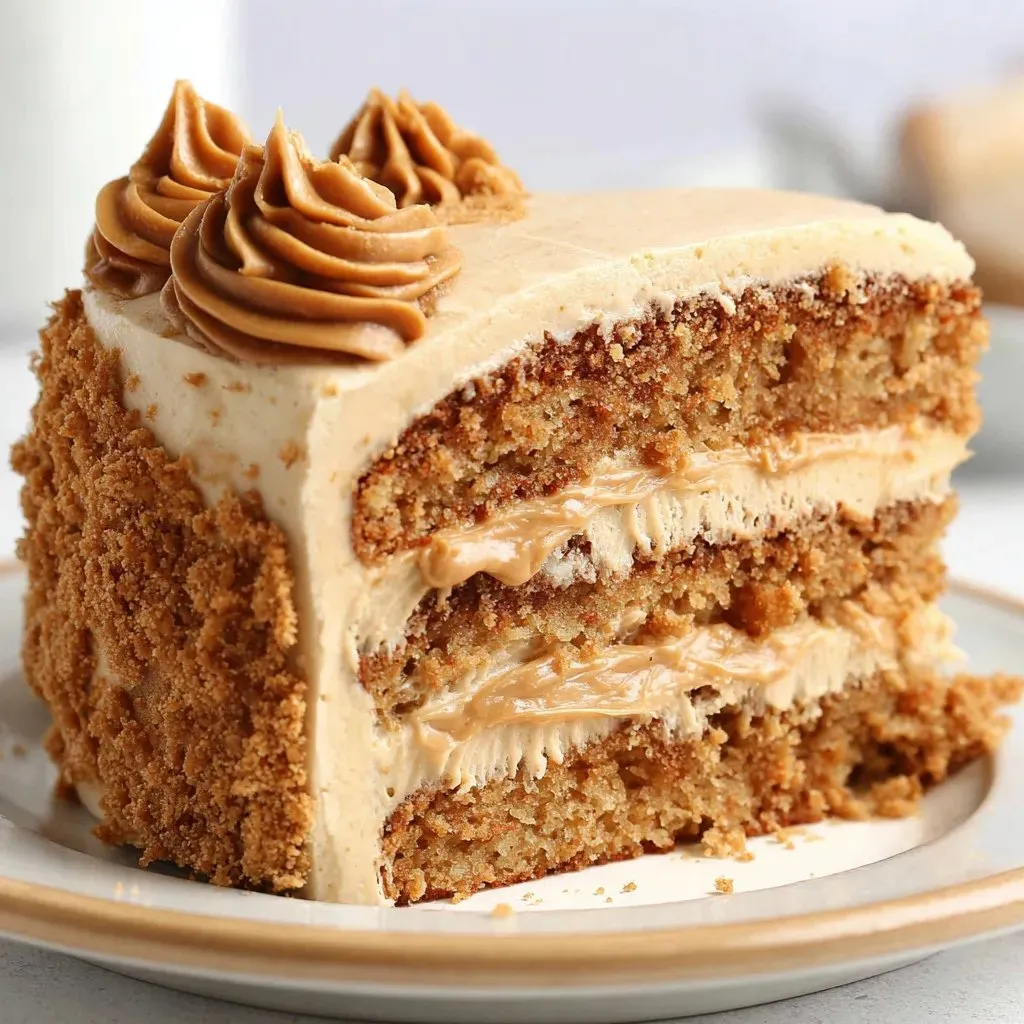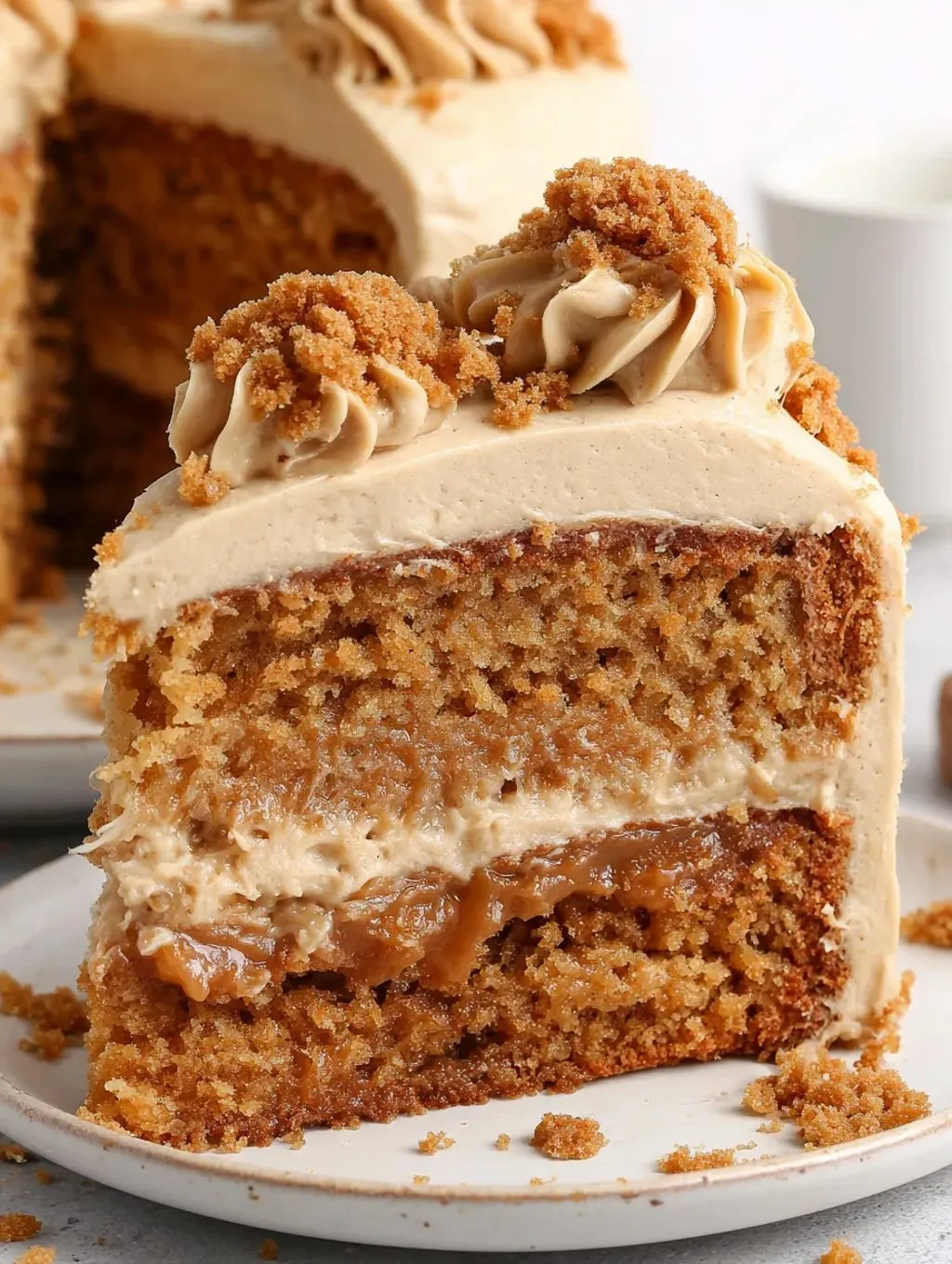 Save
Save
This Moist Biscoff Cake brings together the warm spiced flavors of cinnamon and the unique caramelized notes of Biscoff spread for a dessert that feels like a cozy slice of cookie heaven. Soft, tender, and richly flavored, it’s perfect for celebrations or simply when you need a special treat to brighten your day.
I first made this cake for a family gathering and it was devoured so quickly that it became an instant favorite. Now it’s my go-to dessert whenever I want something comforting yet impressive.
Ingredients
- All-purpose flour: provides the essential structure needed to support the cake’s tender crumb
- Cornstarch: ensures a moist and light texture by softening the flour’s protein content
- Baking soda and baking powder: work together to give the cake a fluffy rise and lightness
- Salt: enhances all the flavors but skip if you use salted butter
- Ground cinnamon: adds warmth and depth balancing the sweetness perfectly
- Unsalted butter: brings richness and moisture use at room temperature for easy mixing
- Vegetable oil: contributes additional moistness ensuring the cake stays soft
- Light brown sugar: adds caramel notes and sweetness pack firmly for accuracy
- Large eggs: bind the ingredients and add richness best used at room temperature
- Biscoff spread: lends a distinctive cookie butter flavor that makes the cake special
- Vanilla extract: brightens and elevates all the other flavors
- Buttermilk: adds acidity and moisture creating a tender crumb a vinegar and milk mix works if you do not have buttermilk
- Crushed Biscoff cookies: incorporated into the batter add a wonderful crunch and texture
- Powdered sugar: is key for the smooth fluffy frosting sweetness
- Milk or heavy cream: is used to thin the frosting to your preferred consistency
- Extra Biscoff cookies: for decoration elevate the cake’s look and offer a crunchy bite
Step-by-Step Instructions
- Preheat the Oven:
- Set your oven to 180 degrees Celsius or 350 degrees Fahrenheit. Grease two 8-inch cake tins thoroughly and line them with parchment paper to ensure the cakes will release easily after baking.
- Mix the Dry Ingredients:
- Sift together all-purpose flour cornstarch baking soda baking powder salt and ground cinnamon into a large mixing bowl. This mix builds the dry foundation for your cake and evenly distributes the leavening agents and spices.
- Cream the Butter and Sugar:
- In a separate large bowl cream the unsalted butter vegetable oil and light brown sugar together for approximately 2 minutes until the mixture becomes light smooth and fluffy. This step is essential because properly creamed fats trap air that make the cake light and tender.
- Incorporate the Eggs and Flavorings:
- Add the eggs one at a time to the butter mixture mixing well after each addition to ensure good incorporation. Stir in the Biscoff spread and vanilla extract until the batter is smooth and homogenous infusing it with signature cookie butter flavor and aroma.
- Fold in the Dry Ingredients:
- Add the dry ingredient mixture in portions alternating with the buttermilk. Use gentle folding motions to combine everything evenly avoiding overmixing which could make the cake dense.
- Add Biscoff Cookies:
- Fold in the crushed Biscoff cookies carefully until evenly distributed throughout the batter adding delightful crunch to every bite.
- Bake the Cake:
- Pour the batter evenly between the prepared cake tins and tap gently on the counter to release air bubbles. Bake in the preheated oven for 37 to 40 minutes or until a toothpick inserted into the center emerges clean.
- Cool the Cakes:
- Let the cakes cool in the tins for about 20 minutes to stabilize their structure then transfer to a wire rack to cool completely before frosting. This step is important to prevent sogginess.
- Prepare the Frosting:
- Grind the remaining Biscoff cookies into fine crumbs. Beat unsalted butter powdered sugar vanilla extract salt and milk together on low speed until just combined. Then whip on high for approximately 10 minutes until light and fluffy. Finally fold in the Biscoff spread and cookie crumbs carefully for a rich and textured buttercream.
- Frost the Cake:
- Level the tops of the cooled cakes for equal layers. Spread a layer of the Biscoff buttercream between the layers then generously cover the top and sides. Decorate with whole or crumbled Biscoff cookies for that extra cookie crunch. For a special touch drizzle some extra Biscoff spread over the top.
 Save
Save
One of my favorite parts is the crushed cookies folded into the batter. The way they soften just enough but still keep their crunch reminds me of sharing laughter and treats with family on lazy Sundays.
Storage Tips
Wrap leftover cake tightly in plastic wrap or store in an airtight container. Refrigerate for up to five days. Before serving allow the cake to come to room temperature for best texture and flavor. You can also freeze the unfrosted layers by wrapping them well. Thaw overnight in the refrigerator before frosting.
Ingredient Substitutions
You can swap vegetable oil for canola oil without changing the texture. If you do not have buttermilk mix regular milk with a tablespoon of vinegar or lemon juice and let it rest for 5 minutes as a substitute. Light brown sugar can be replaced with dark brown sugar for a deeper molasses flavor if preferred.
Serving Suggestions
This cake pairs wonderfully with a cup of coffee or warm chai tea to complement the spice and caramel notes. Serve slices with fresh whipped cream or a scoop of vanilla ice cream for an indulgent treat. Garnish with extra crushed Biscoff cookies or a drizzle of caramel sauce for a beautiful presentation.
Cultural Context
Biscoff spread originates from Belgium and is beloved for its unique caramelized cookie flavor. Incorporating it into cakes transforms classic American baking with a European twist that brings nostalgia and excitement. This cake is perfect for sharing at gatherings where comfort and richness are prized.
Recipe FAQs
- → What keeps the cake moist?
The combination of buttermilk, vegetable oil, and unsalted butter helps retain moisture and tenderness throughout baking.
- → Can I substitute regular milk for buttermilk?
Yes, mixing regular milk with vinegar or lemon juice and resting it for a few minutes creates a suitable buttermilk alternative that maintains moisture and acidity.
- → How are the Biscoff cookies used in the cake?
Crushed Biscoff cookies are gently folded into the batter for added crunch and sprinkled over the frosting for texture contrast.
- → How do I get a fluffy buttercream frosting?
Beat butter and powdered sugar on low speed initially, then increase to high and whip for about 10 minutes with milk until light and airy before folding in Biscoff spread and crumbs.
- → Why is cooling important before frosting?
Allowing the cake to cool completely prevents frosting from melting and helps achieve clean, even layers and neat decoration.
- → Is ground cinnamon necessary in this cake?
While cinnamon adds warmth and depth, it can be omitted without losing the signature caramelized Biscoff flavor.
